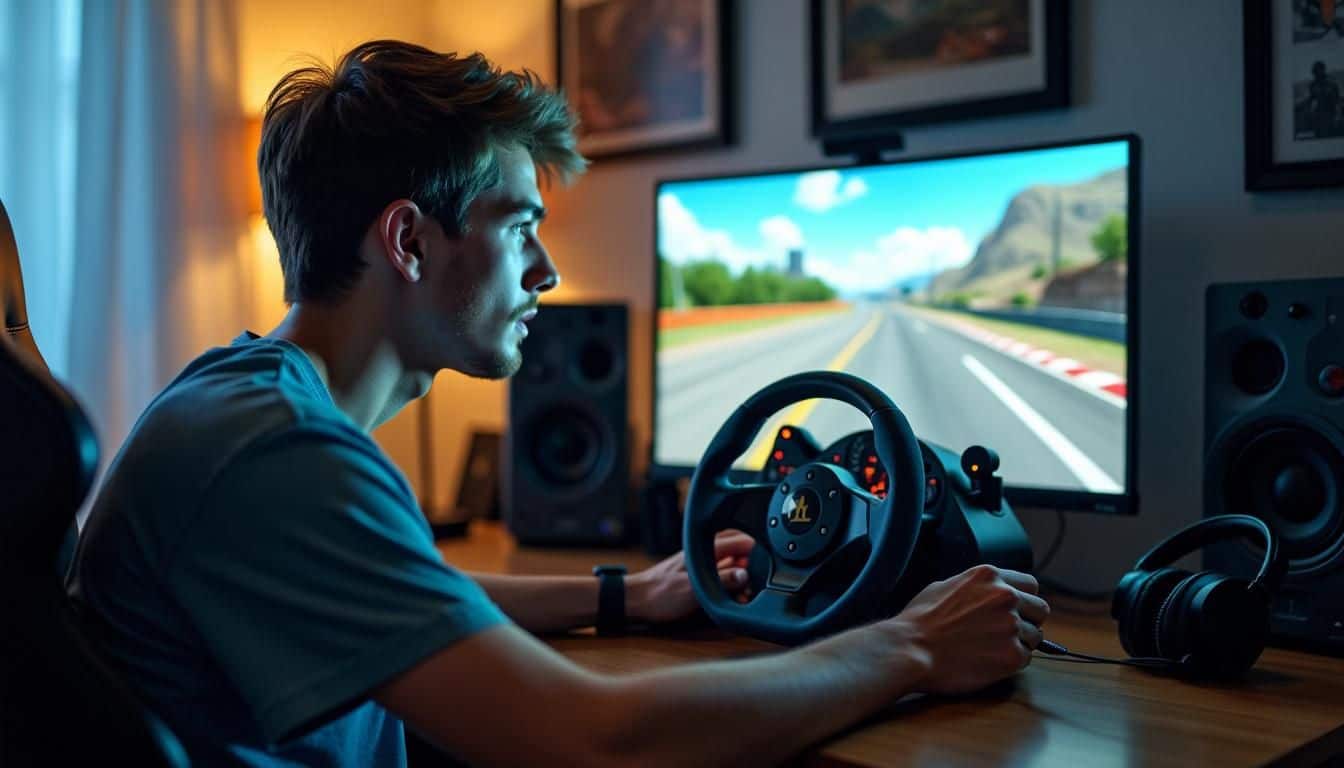Ever felt like your racing game just doesn’t cut it? You’re not alone. Racing games have come a long way since the days of pixelated cars on blocky tracks. Today’s top-tier racing sims offer unparalleled realism. 1 This article will pit five of the most lifelike racing games against each other.
Ready to burn some virtual rubber? 2
Key Takeaways
The top 5 most realistic racing games are Assetto Corsa, iRacing, Project CARS 2, Forza Motorsport (2023), and Gran Turismo 7.
Key factors for realism include accurate physics, detailed graphics and sound, true-to-life tracks, and authentic vehicle designs. Games like iRacing use laser-scanned tracks for precision.
Assetto Corsa and iRacing lead in physics and handling. Project CARS 2 excels in weather effects. Forza Motorsport (2023) and Gran Turismo 7 offer huge car rosters with over 400 vehicles each.
New trends include VR/AR integration, evolving weather systems, and enhanced damage effects. The VR/AR racing game market is set to grow from 2024 to 2031.
Online competitions and user-generated content are expanding rapidly. Major racing series now partner with games like iRacing for official online leagues.
Table of Contents
Defining Realism in Racing Games
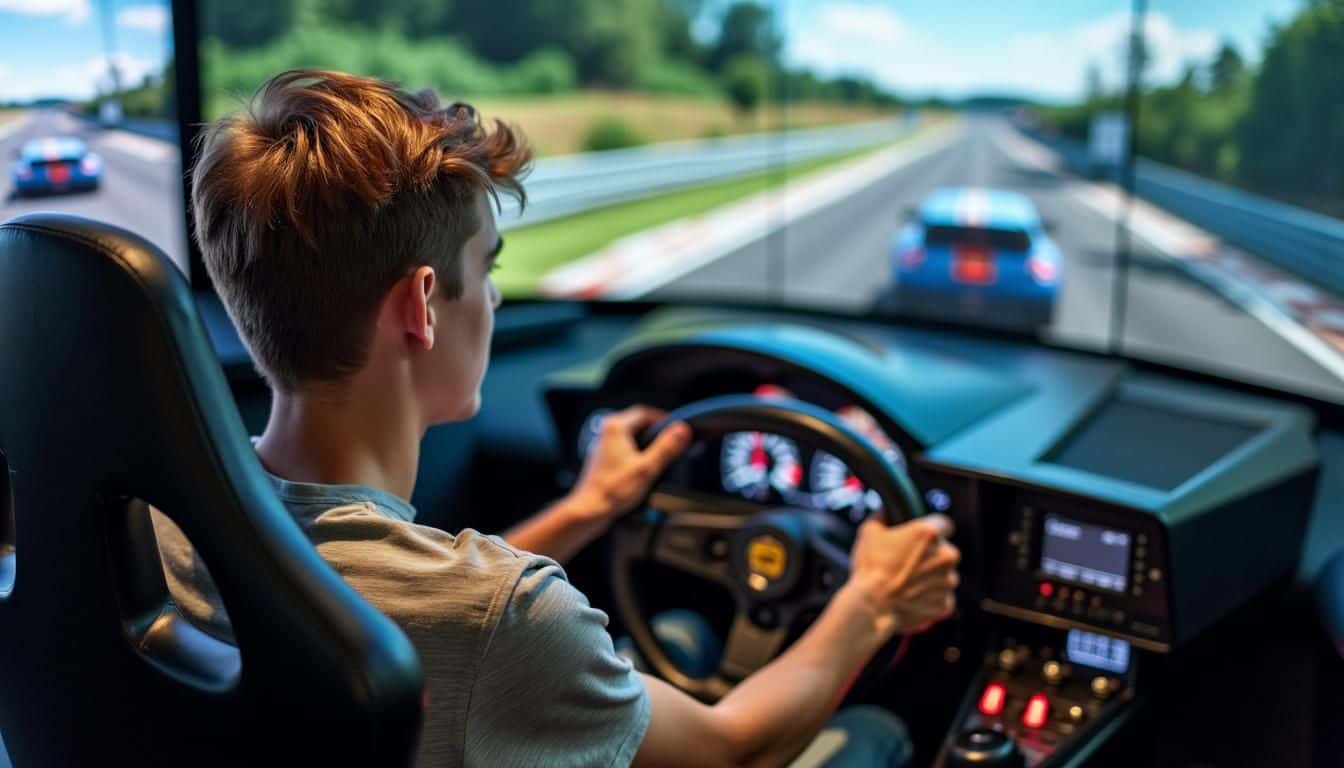
Realism in racing games goes beyond flashy graphics. It’s about nailing the feel of the car, the roar of the engine, and the thrill of the track.
Physics and Driving Mechanics
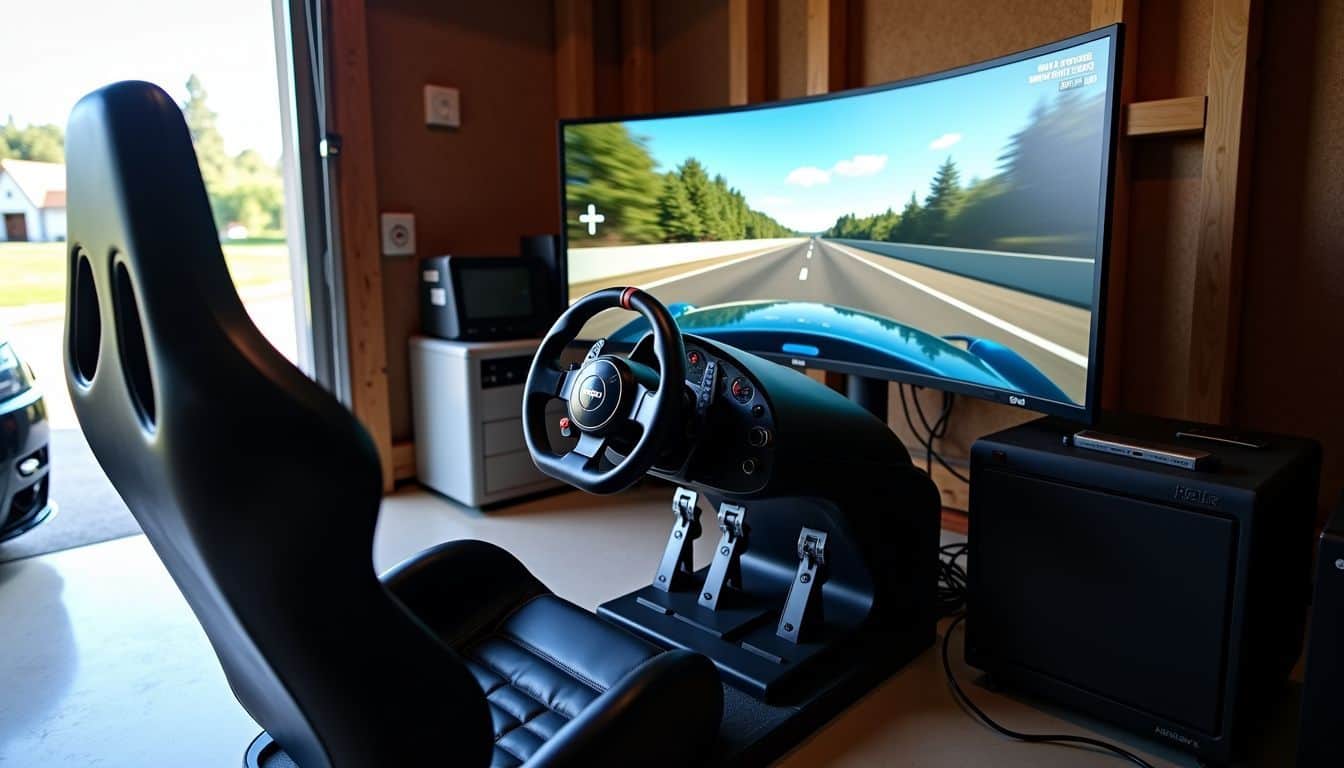
Racing games live or die by their physics and driving mechanics. These elements form the core of any makes a good video game in the racing genre.
Top-notch sims like iRacing and Assetto Corsa shine here. They nail the feel of each car, from how it grips the road to how it reacts when you slam on the brakes. 2 These games use complex math to mimic real-world physics, making every turn and drift feel true to life.
But it’s not just about how the car moves. It’s also about how you control it. The best racing sims let you tweak every aspect of your ride. You can adjust tire pressure, suspension, and even aerodynamics. 1 This level of detail is what sets apart the great from the good. It’s why gear-heads and pro drivers alike turn to these games to hone their skills. Next up, we’ll look at how visuals and sound add to the realism.
Visual and Audio Effects
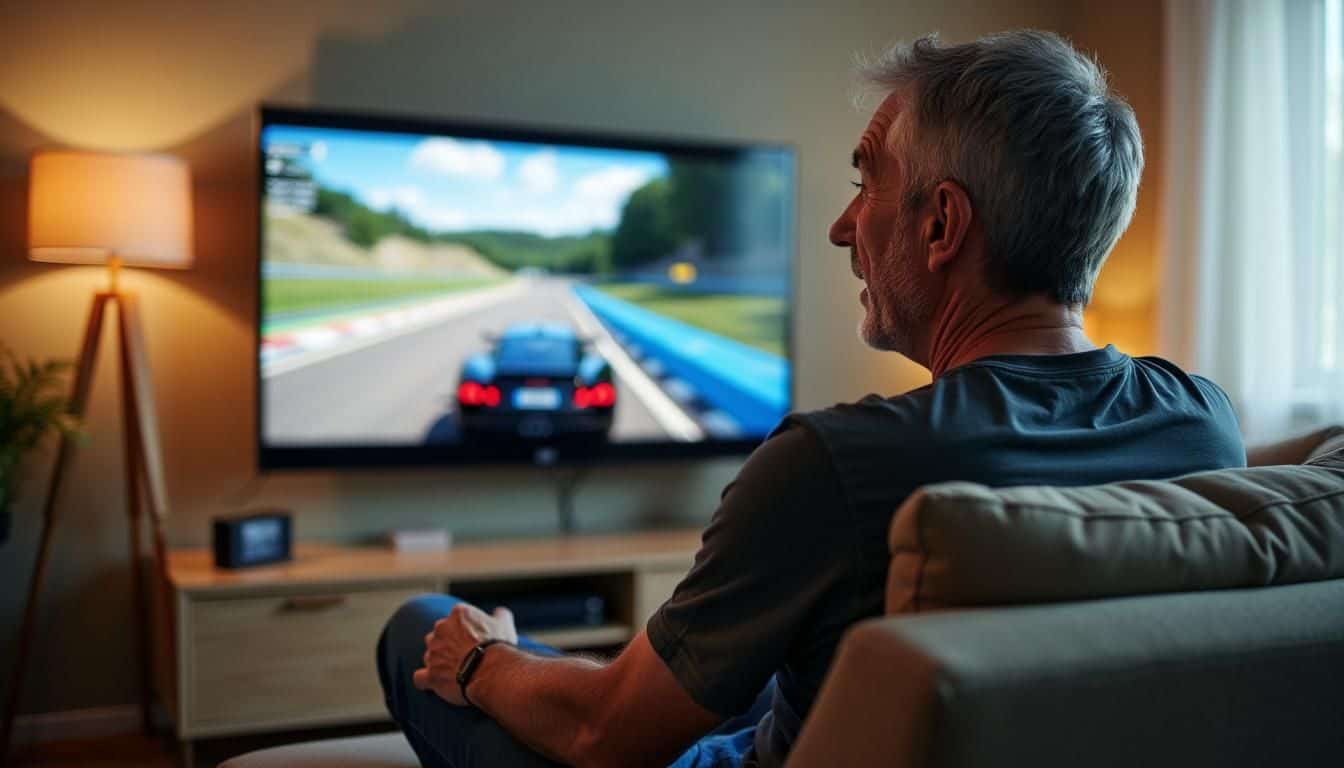
Visual and audio effects in racing games have come a long way. Today’s top titles boast jaw-dropping graphics and sound that’ll make your ears perk up. Take Forza Motorsport (2023), for example.
It’s a feast for the eyes with its lifelike cars and tracks. The audio is no slouch either – you’ll hear every rev and screech as if you’re right there on the track.
Gran Turismo 7 takes things up a notch with its photo-realistic visuals. It’s so pretty, you might forget you’re playing a game! But looks aren’t everything. RaceRoom Racing Experience shines in the sound department.
Its audio design is so good, you’ll swear you can smell the burning rubber. These games prove that great visuals and sound can make or break the racing experience. 1
The roar of the engine, the squeal of tires – that’s what brings a racing game to life, says a seasoned sim racer. 3
Track Layouts and Details
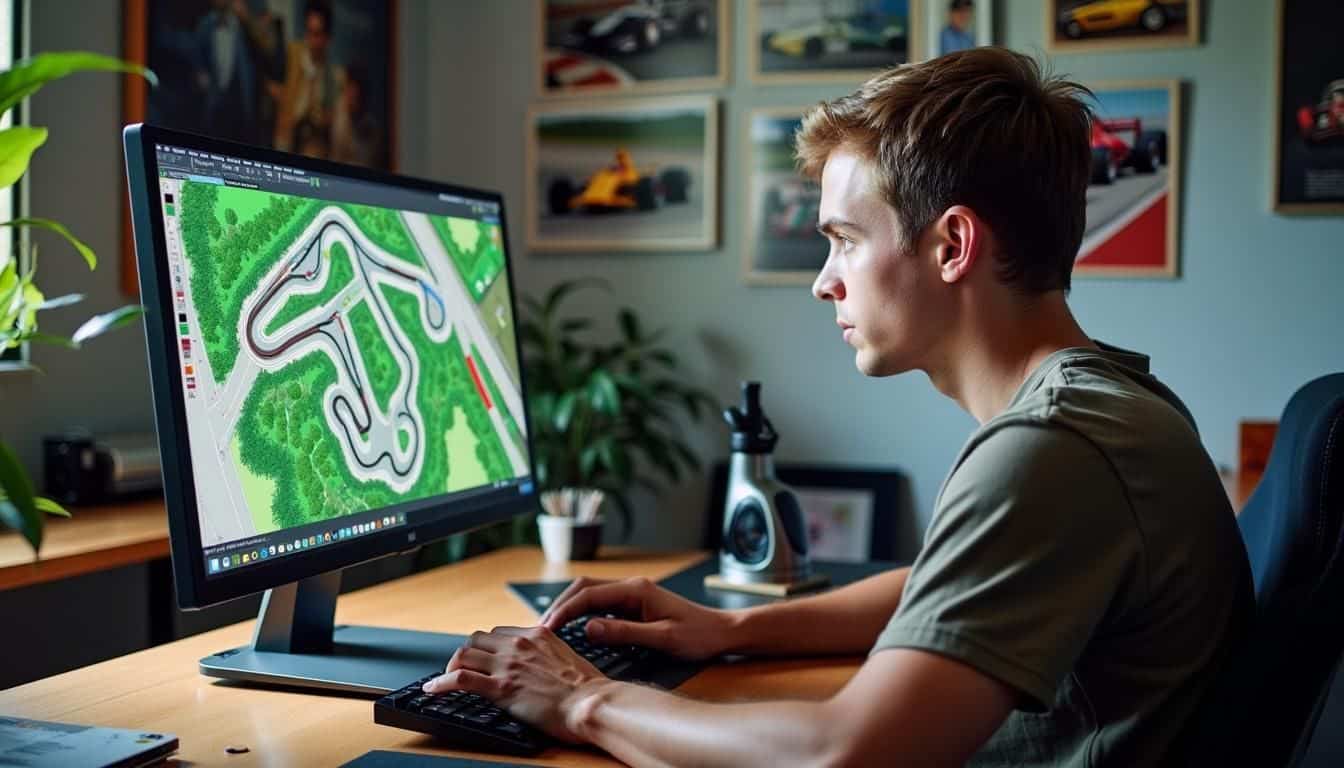
Moving from the sights and sounds, let’s hit the tracks. Racing games live or die by their circuits. Top-notch games offer laser-scanned tracks that mirror real-world counterparts down to the last bump and kerb.
iRacing leads the pack with over 100 true-to-life tracks.4 Assetto Corsa Competizione isn’t far behind, boasting 25+ laser-scanned circuits. These games don’t just look right – they feel right too.
Every dip, rise, and corner matches reality. It’s like driving the real thing… minus the g-forces and risk of crashing a million-dollar car!1
Vehicle Design and Authenticity

Racing games live or die by their cars. Top sims nail every detail, from body shape to engine sound. They capture the soul of each ride. Gran Turismo 7 leads the pack with over 400 true-to-life vehicles.
That’s a lot of eye candy! But it’s not just about looks. These games recreate how each car handles on the track. Assetto Corsa, with its 178 cars, is known for spot-on driving feel.
It’s like you’re really behind the wheel. 1
Realism goes beyond the cars, though. The tracks matter too. iRacing is a champ here. It uses laser scans to copy real-world circuits down to the inch. Every bump, every turn – it’s all there.
Project CARS 2 takes it up a notch with 60 tracks and wild weather effects. Rain, snow, or shine – you’ll feel like you’re really there. It’s not just racing… it’s time travel to the world’s best tracks! 4
Leading Realistic Racing Games

Buckle up, racing fans! We’re about to hit the gas on the most heart-pounding, tire-screeching sims out there. These games don’t just look real – they feel real. From the grip of the tires to the roar of the engines, they’ll make you sweat…
Ready to find out which ones top the list? Let’s dive in!
Assetto Corsa

Assetto Corsa is a racing sim that’ll make your heart race. Released in 2014 by Kunos Simulazioni, it’s a gear-head’s dream. 5 With 178 cars and 19 tracks, you’ll never run out of rubber to burn.
The game’s physics are so spot-on, you might forget you’re not actually behind the wheel. It’s like getting to rent sports cars without leaving your couch!
I’ve spent countless hours in Assetto Corsa, and let me tell you – it’s addictive. The VR compatibility takes it to another level. You can almost feel the g-forces as you zip around Silverstone or tackle the Nürburgring.
Plus, the mod community keeps things fresh with new cars and tracks. It’s a playground for racing fans that keeps on giving. 6
iRacing

iRacing stands out as a top-tier racing sim. It boasts over 100,000 subscribers who crave its ultra-realistic tracks. The game uses laser scanning tech to nail every curve and bump. 7 This attention to detail makes iRacing a hit with serious racers.
But realism comes at a price. New cars cost $11.99, while tracks go for $14.99. There’s also a monthly fee to play. Still, many fans think it’s worth it. The game’s founders, John Henry and Dave Kaemmer, started iRacing in 2008.
They’ve built a racing world that feels real enough to touch.
iRacing isn’t just a game, it’s a virtual racetrack in your living room. 8
Project CARS 2

Project CARS 2 ups the ante in racing games. It’s loaded with 180 cars and 60 tracks to choose from. 9 But the real game-changer? Its weather system. You’re speeding down the track when – bam! – rain starts pouring.
Puddles form in real-time, making your tires lose grip. It’s like racing against Mother Nature herself.
The game doesn’t stop there, though. It takes you on a ride through various motorsports in career mode. One day you’re tearing it up in a stock car, the next you’re handling a Formula One machine.
It’s a buffet of racing thrills, all in one package. And the graphics? They’re so sharp, you might think you’re actually driving. 10
Forza Motorsport (2023)

Forza Motorsport (2023) revs up the racing scene with a jaw-dropping lineup. Turn 10 Studios packed this bad boy with 500 licensed cars and 20 real tracks. 11 That’s a lot of rubber to burn! The game runs smooth as silk at 60 frames per second on Xbox Series X and S. 12 It’s like butter on a hot pan.
But it’s not just about speed. Forza wants you to play nice on the track. The online mode pushes for clean racing – no bumper cars here, folks! It’s all about skill, not chaos. This game aims to give gearheads a taste of real racing thrills…
minus the risk of wrecking a million-dollar car.
Gran Turismo 7

Gran Turismo 7 is a racing fan’s dream come true. It packs over 400 cars and 63 tracks into one game. 13 That’s a lot of rubber to burn! The devs didn’t stop there, though. They keep adding new stuff every month.
It’s like Christmas for gearheads all year round.
GT7 isn’t just about quantity – it’s got quality too. The cars look so real, you might try to climb into your TV. And the tracks? They’re spot-on copies of real-world circuits. You’ll feel like you’re really zooming around Silverstone or tackling the Nürburgring.
Gran Turismo 7 isn’t just a game, it’s a love letter to cars and racing.
Plus, with PS5 power, it runs smoother than a freshly waxed hood. 14
In-Depth Analysis of Top Games

Let’s dive into the nitty-gritty of these top racing games! Each one brings something special to the table – from jaw-dropping graphics to physics that’ll make you feel every bump in the road.
Buckle up, ’cause we’re about to take a wild ride through the best of the best….
Assetto Corsa: Community Mods and Handling Precision
Assetto Corsa keeps racing fans hooked with its spot-on handling and tons of mods. Players love how the cars feel real – they grip the road just right and respond like actual racers. 16 But the game’s true magic? Its huge mod scene. Thousands of fan-made add-ons take Assetto Corsa to new heights. From extra tracks to tweaked cars, there’s always something fresh to try. 15
Want the best Assetto Corsa experience? Grab the “Content Manager” and “Custom Shaders Pack” mods. They’re must-haves for serious racers. And don’t skip the “Soul” mod – it makes everything look way better and more lifelike.
With these upgrades, Assetto Corsa stays a top pick for sim racing in 2023. Its strong Steam player count proves it’s still burning up the virtual tracks. 15
iRacing: Online Races and Precision Tracks
Moving from Assetto Corsa’s mods, let’s shift gears to iRacing’s online races. iRacing takes sim racing to new heights with its laser-scanned tracks and strict rules. 17 It’s not just a game – it’s a full-on racing system.
Players climb through license levels, from D to A, unlocking cooler cars as they go.
iRacing’s online races are the real deal. They use a tough penalty system to keep racers in line. 18 Your every move affects your Safety Rating and iRating. These scores show how safe and skilled you are on the track.
It’s like having a racing resume that follows you everywhere. The game’s precision tracks make you feel like you’re really there, burning rubber on famous circuits around the world.
Project CARS 2: Climate Effects and Diverse Vehicles
iRacing nails online races and track precision. But Project CARS 2 takes the wheel with its wild weather and car variety. This game throws you into a storm – literally. You’ll battle thunderstorms and blizzards while racing.
It’s like Mother Nature joined the pit crew! 19
Project CARS 2 doesn’t just stop at weather. It gives you 180 cars to choose from. That’s enough to make a car collector drool. You can race on 60 tracks across 29 motorsports. From F1 to rally, it’s got it all.
The career mode lets you climb the ranks in different racing styles. Just watch out for the AI – it can be a bit wonky at times. Still, the sheer range of options makes Project CARS 2 a top pick for racing fans. 9
Forza Motorsport (2023): Cutting-Edge Technology
Forza Motorsport (2023) is a gear-head’s dream come true. This game packs a punch with over 400 cars right out of the box. 20 That’s enough to keep even the most die-hard car nuts busy for months! But it’s not just about quantity.
The devs have cooked up a sweet “CarPG” system that lets you level up your rides as you race. It’s like your car grows with you – pretty cool, right?
But here’s where it gets really wild. The tech behind this game is next-level stuff. We’re talking ray tracing, dynamic weather, and physics so real you can almost feel the g-forces.
I’ve spent hours just gawking at how light bounces off the paint jobs. It’s like being in a virtual car show… except you get to drive everything! Next up, let’s dive into how Gran Turismo 7 stacks up against this beast. 21
Gran Turismo 7: Extensive Car Roster and Authentic Drives
Gran Turismo 7 revs up the nostalgia engine with its massive car lineup. It’s got over 400 rides to choose from, each one a slice of automotive history. The game’s GT Café mode serves up 39 tasty challenges, letting you dig deep into car culture. 22 It’s like a buffet for gearheads – sample a bit of everything or gorge on your favorites.
But GT7 isn’t just about quantity. It’s got quality in spades. The driving feels real – you can feel the weight shift as you take corners. 13 The visuals? They’re eye-popping. And the sound? It’s music to a petrolhead’s ears.
It’s one of the best racing games out there, blending realism with pure fun. Whether you’re a casual driver or a hardcore sim fan, GT7’s got something for you.
New Trends in Realistic Racing Experiences
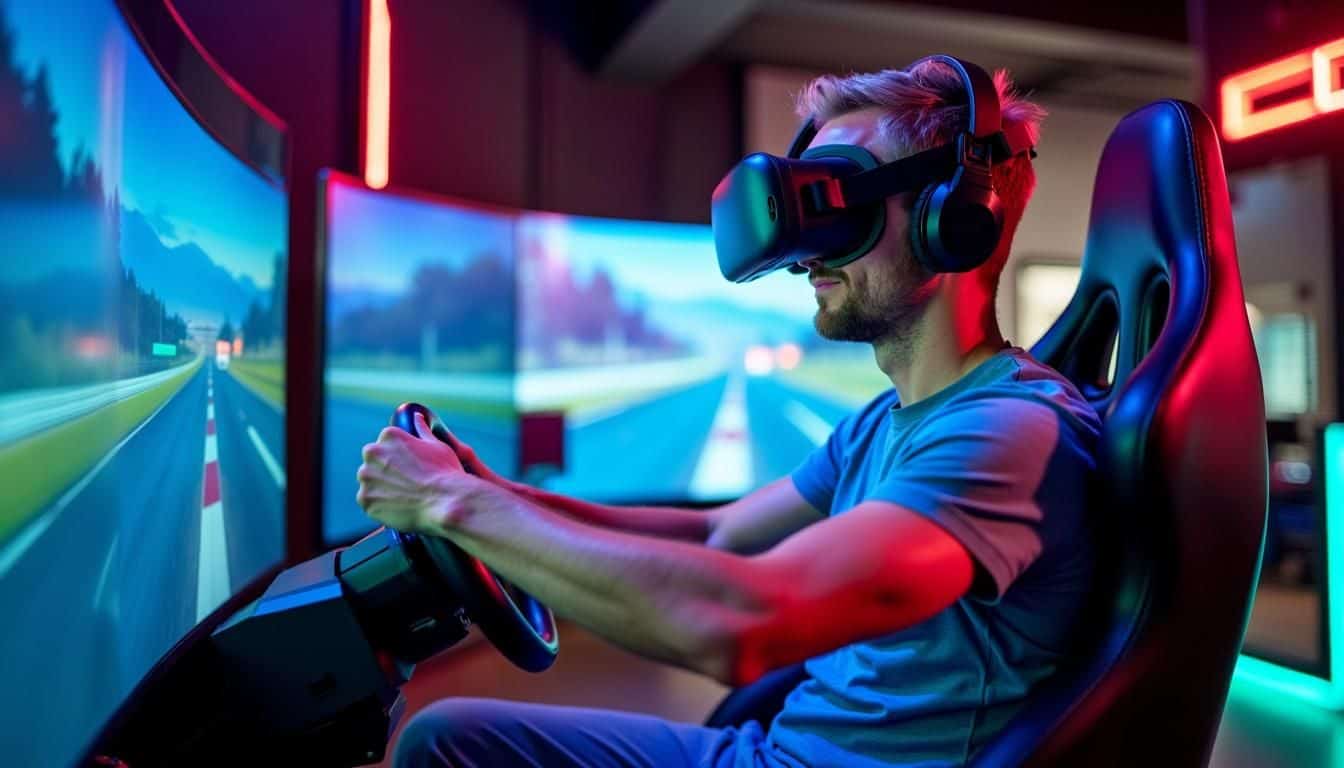
Buckle up, speed demons! Racing games are shifting gears with mind-blowing tech. From VR that puts you in the driver’s seat to weather that changes on a dime, these new trends are revving up the realism.
Want to know what’s next on the track? Keep reading – it’s gonna be a wild ride!
Virtual and Augmented Reality Innovations
Virtual and augmented reality are changing racing games big time. Imagine strapping on a headset and feeling like you’re really behind the wheel! These new tech toys let you look around the cockpit, check your mirrors, and even feel the g-forces.
It’s wild stuff. The market for VR and AR racing games is set to zoom ahead from 2024 to 2031. 23 More folks are buying these gadgets, which is great news for racing fans.
But it’s not all smooth driving. VR headsets can cost a pretty penny, and there aren’t tons of games yet. 24 Still, the future looks bright. Developers are working hard to create more realistic experiences.
Soon, you might be able to smell burning rubber or feel the spray of champagne on the winner’s podium. How cool is that? It’s like being a real race car driver… minus the risk of crashing!
Evolving Weather Conditions
Racing games have come a long way in mimicking real-world weather. Forza Motorsport leads the pack with its complex weather systems. 25 These games now copy actual weather patterns like evaporation and pressure zones.
It’s not just about rain or shine anymore. The sky changes, clouds move, and tracks dry up over time. This adds a whole new layer to racing strategy.
Dynamic weather isn’t just eye candy – it changes how you drive. A dry track might suddenly get slick with rain. Or a foggy morning could clear up mid-race. You’ve got to adjust your driving on the fly.
It’s like Mother Nature is your toughest rival. These evolving conditions keep racers on their toes and make each lap a fresh challenge. 1
Enhanced Damage Effects
Damage effects in racing games have come a long way. Project Cars 2 leads the pack with both visual and mechanical damage. Cars crumple, parts fly off, and performance takes a hit.
It’s not just about looks – your driving feels the impact too. BeamNG.drive takes it up a notch with soft body physics. Crash your car and watch it bend and warp in real-time. It’s like playing with a virtual stress ball…
but way cooler. 26
Console gamers, don’t feel left out! Wreckfest brings the pain to your living room. Smash, crash, and bash your way through races. The damage looks so good, you might forget you’re supposed to be racing.
These games make every scrape and collision count. It’s not just about crossing the finish line – it’s about how beat up you look when you get there. 1
Community and eSports Contributions

Racing games have gone beyond solo play. Online competitions and user-made content are changing the game.
Expansion of Online Racing Competitions
Online racing has exploded in popularity. Gamers now compete in huge virtual events from their homes. Major racing series like NASCAR and IMSA have partnered with iRacing to create official online leagues.
These digital races draw thousands of fans and even pro drivers. The pandemic boosted online racing’s appeal, with many real-world events canceled. 28E-sports tournaments for racing games are growing fast. Big prize pools and live streaming bring in loads of viewers. Sim racers can now make a living from online competitions. Racing game developers are adding more multiplayer features to tap into this trend.
Online leagues let players climb the ranks just like in real motorsports. It’s an exciting time for virtual racing fans! 27
User-Generated Content and Modifications
Geeks love to tinker, and racing games are no exception. Mods and user-created content breathe new life into these games. Fans craft custom tracks, cars, and even entire gameplay overhauls.
It’s like having a never-ending supply of fresh content. Some games, like Assetto Corsa, thrive on this community-driven approach. 30.
Modding isn’t just about adding stuff – it’s about making the game your own. Want to race F1 cars on the moon? There’s probably a mod for that. These tweaks can range from simple visual changes to complex physics adjustments.
The best part? Many developers encourage this creativity, offering tools and support for modders. It’s a win-win: players get more content, and games stay relevant longer. 29.
People Also Ask
What makes a racing game realistic?
Realistic racing games nail driving physics and handling. They capture how cars behave on different tracks. The best ones use advanced engines like Unreal or Madness. They offer force feedback for wheels. Games like rFactor 2 and Dirt Rally shine here.
Which racing game has the best graphics?
Forza Horizon 5 is a stunner. It’s eye candy on wheels. But Gran Turismo Sport and Forza Motorsport 7 aren’t far behind. These games make you feel like you’re really there, from Donington to Road Atlanta.
Are there any good motorcycle racing games?
You bet! MotoGP and Ride 4 lead the pack for two-wheelers. They’re a blast for motorcyclists. If you want something wilder, try the Dakar Desert Rally. It’s like the real deal, minus the sand in your boots.
Can I race on famous tracks in these games?
Absolutely! Many games feature iconic circuits. You can tear up Silverstone, conquer Circuit de Catalunya, or tackle Le Mans. It’s like a world tour from your couch. Some even let you race the Snaefell Mountain Course!
Do I need special equipment to play these games?
For casual play, a controller works fine. But for the full experience, gear up! A direct-drive wheel and pedals can transform your race. It’s not cheap, but it’s worth it for die-hard fans. Just don’t blame us if you start dreaming about understeer!
Which game is best for multiplayer racing?
GT World Challenge Europe in Assetto Corsa Competizione is a top pick. It’s great for online battles. iRacing has a killer subscription model for serious racers. For more laid-back fun, try Forza Horizon’s open world. Race with friends or strangers – it’s a party on wheels!
References
^ https://www.asetek.com/simsports/guides/most-realistic-racing-simulator-everything-you-need-to-know/ (2024-06-13)
^ https://polydin.com/racing-game-mechanics/ (2024-01-28)
^ https://www.researchgate.net/publication/265601071_Effects_of_sound_on_visual_realism_perception_and_task_performance
^ https://gamerant.com/most-realistic-racing-games/
^ https://www.autoevolution.com/news/the-7-most-realistic-car-racing-sim-games-ranked-235787.html (2024-06-23)
^ https://simracingcockpit.gg/sim-racing-games/ (2024-04-12)
^ https://www.build4performance.com/en/the-most-realistic-racing-game-ever-iracing/
^ https://www.iracing.com/iracing-vs-the-real-thing/
^ https://www.ign.com/articles/2017/09/18/project-cars-2-review (2017-09-18)
^ https://www.wired.com/story/project-cars-2-most-advanced-racer-vr-esports/ (2017-02-13)
^ https://gamecritics.com/darren-forman/forza-motorsport-2023-review/ (2023-11-29)
^ https://www.cnn.com/cnn-underscored/electronics/forza-motorsport-2023-hands-on (2023-09-11)
^ https://www.hagerty.co.uk/articles/maintenance-and-gear/gran-turismo-7-review-the-racing-game-it-took-25-years-to-perfect/
^ https://www.forbes.com/sites/olliebarder/2022/03/29/despite-its-flaws-gran-turismo-7-is-still-a-really-good-racing-game/ (2022-03-29)
^ https://www.youtube.com/watch?v=8e566aQNGog
^ https://steamcommunity.com/app/244210/discussions/0/3184610754205526246/?l=greek
^ https://www.iracing.com/racing-games/
^ https://www.gamespot.com/reviews/project-cars-2/1900-6416766/
^ https://www.analogstickgaming.com/game-reviews-1/2023/10/30/forza-motorsport-2023
^ https://www.ign.com/articles/forza-motorsport-review
^ https://powerup-gaming.com/2022/03/02/gran-turismo-7-review-ps5-the-bloody-unreal-driving-simulator/
^ https://www.linkedin.com/pulse/augmented-reality-ar-virtual-vr-racing-games-pnbsf
^ https://www.linkedin.com/pulse/augmented-reality-ar-virtual-vr-racing-games-h8pwf
^ https://www.bbc.com/news/newsbeat-67155047
^ https://www.youtube.com/watch?v=43Cn8bDcGMk
^ https://www.researchgate.net/publication/381024865_The_Development_of_Esports_Research_and_Technology_in_the_Last_3_Decades
^ https://ieee-cog.org/2022/assets/papers/paper_174.pdf
^ https://www.pubnub.com/blog/understanding-user-generated-content-in-gaming/ (2024-03-12)
